

Oktay Mercimek, EMAT 6690
Step 5: Ellipse and Hyperbola
To be able to construct Ellipse and Hyperbola in GSP, we need to know geometric definition of ellipses.
Ellipse is the locus of points on a plane where the sum of the distances from any point on the curve to two fixed points is constant. The two fixed points are called foci (plural of focus).
Hyperbola is the locus of points where the difference in the distance to two fixed points (called the foci) is constant.
Ellipse Construction:
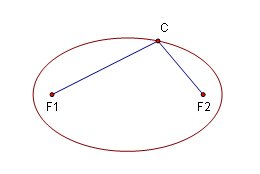 Image 1
Image 1
According to geometric definition of the ellipse,
 and this equation must hold for any point on
the ellipse.
and this equation must hold for any point on
the ellipse.
 Image 2
Image 2
So
 is also true for point D.
is also true for point D.
Let's think about how we can use this fixed distance d. and draw rays
 and
and 
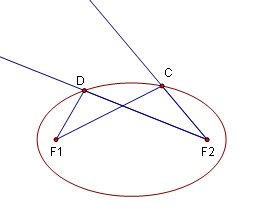 Image 3
Image 3
Then we can
think that segment  can be added to segment
can be added to segment
 on ray
on ray  ,
and segment
,
and segment  can be added to segment
can be added to segment
 on ray
on ray  .
.
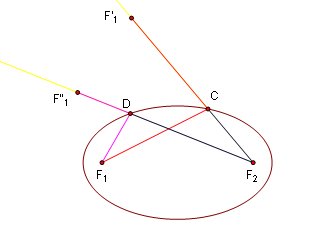 Image 4
Image 4
so
 and
and 
Therefore  . Since C and D are any points
on the ellipse, we can conclude that points that similar to
. Since C and D are any points
on the ellipse, we can conclude that points that similar to
 will be on the circle centered at
point
will be on the circle centered at
point  with radius d.
with radius d.
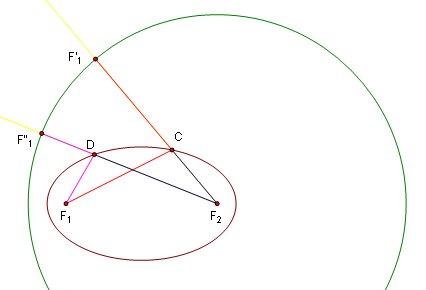 Image 5
Image 5
Now lets turn to starting point and the definition of the ellipse. What we have at the beginning are two foci and a fixed distance d.
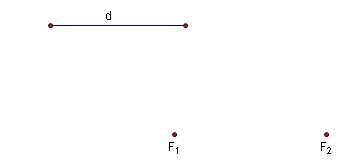 Image 6
Image 6
What we learned that Point  must be on the
circle that is centered at Point
must be on the
circle that is centered at Point 
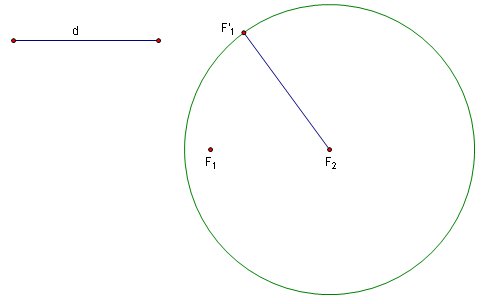 Image
7 : ElliCon3.gsp
Image
7 : ElliCon3.gsp
Now problem is finding the points on the ellipse, e.g. point C. We don't know
where the point C is, however we know that  is a isosceles triangle (see image 5) and we know the base of this triangle,
segment
is a isosceles triangle (see image 5) and we know the base of this triangle,
segment  .
.
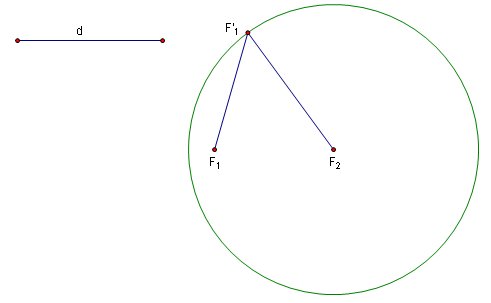 Image 8
Image 8
Then point C must be on the perpendicular bisector of segment
 .
.
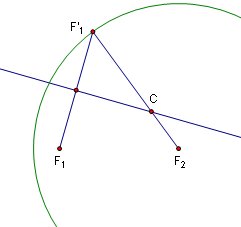 Image 9 :
ElliCon5.gsp
Image 9 :
ElliCon5.gsp
Therefore locus of point C will be the points on the ellipse
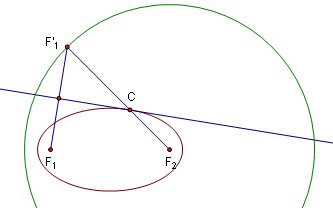 Image 10:
ElliCon6.gsp
Image 10:
ElliCon6.gsp
Reflection Properties of Ellipse:
At this point we can discuss the reflection properties of the ellipse. As we
learned in the parabola page, an important hint about determining reflection
property is finding isosceles triangles i the GSP construction. We already said
that  is a isosceles triangle. Lets construct tis triangle by creating the ray
is a isosceles triangle. Lets construct tis triangle by creating the ray
 .
.
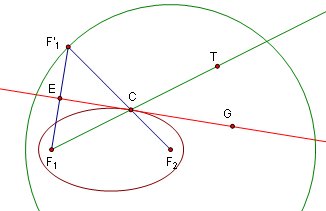 Image 11 :
Ellicon7.gsp
Image 11 :
Ellicon7.gsp
We know  is a isosceles triangle and EC is
perpendicular bisector of this triangle. then we conclude that
is a isosceles triangle and EC is
perpendicular bisector of this triangle. then we conclude that
 (*)
(*)
We also know  and
and
 (**)
(**)
From (*) and (**), we conclude that 
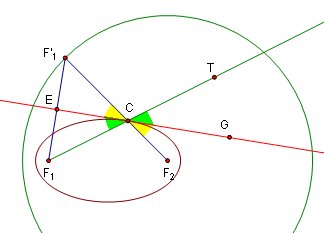 Image 12
Image 12
Inside Reflection Property:
 Image 13:
Ellicon10.gsp
Image 13:
Ellicon10.gsp
Outside Reflection Property:
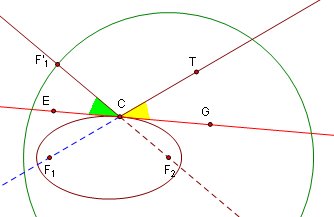 Image 14:
ElliCon11.gsp
Image 14:
ElliCon11.gsp
Ray 
Hyperbola Construction:
Construction of the hyperbola is very similar to construction of the ellipse.
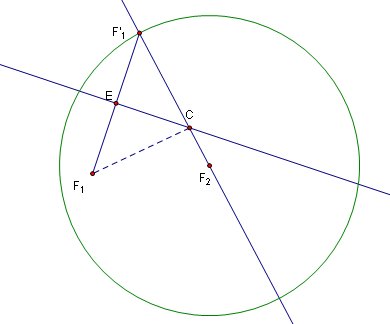 Image 15:
HypCons1.gsp
Image 15:
HypCons1.gsp
This is a sketch from ellipse construction. As we know, E is the midpoint of
segment
 , and CE is the perpendicular bisector of
this segment. Then
, and CE is the perpendicular bisector of
this segment. Then  is an isosceles
triangle. Download HpyCons1.gsp file and Drag point
is an isosceles
triangle. Download HpyCons1.gsp file and Drag point
 outside of the circle.
outside of the circle.
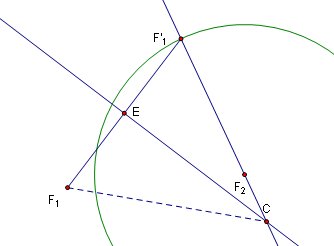 Image 16
Image 16
Now drag point  along the circle and
observe the change of locus of point C. Do you see anything special?
along the circle and
observe the change of locus of point C. Do you see anything special?
 is still an isosceles triangle and segment
is still an isosceles triangle and segment  is the radius of the circle. Lets trace point C to see what is happening.
is the radius of the circle. Lets trace point C to see what is happening.
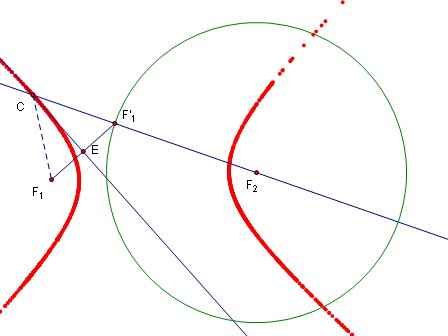 Image 17:
"Trace of Point C" , HypCons2.gsp
Image 17:
"Trace of Point C" , HypCons2.gsp
As you can see, Point C doesn't have to be nearer to Point
 , and what we said before still holds.
, and what we said before still holds.
 is an isosceles triangle and
is an isosceles triangle and
 . so
. so  for
every different Point
for
every different Point  along the circle.
along the circle.
According to geometric definition of the Hyperbola, locus of the Point C is defines the hyperbola.
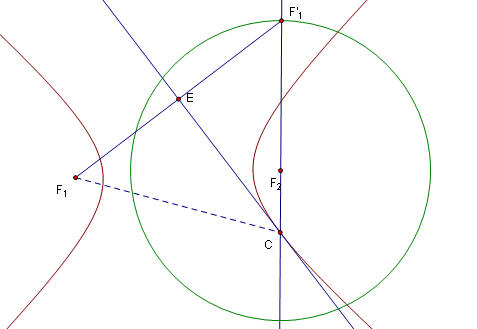 Image 18:Locus of the Point C
Image 18:Locus of the Point C
Reflection Properties of Hyperbola:
Since we constructed hyperbola using isosceles triangles, determining the reflection properties of the hyperbola will not be difficult
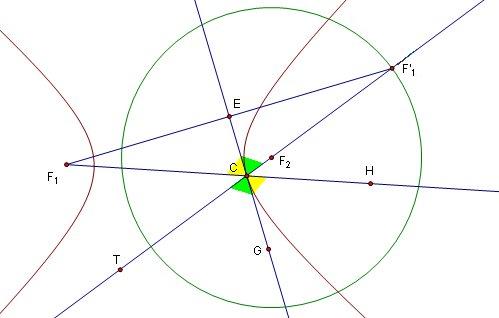 Image 19:
HypCons5.gsp
Image 19:
HypCons5.gsp
 ,
,  and
and

Therefore 
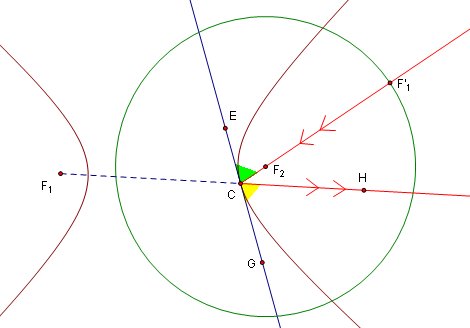 Image 20:
Inside the Hyperbola, HypCons5.gsp
Image 20:
Inside the Hyperbola, HypCons5.gsp
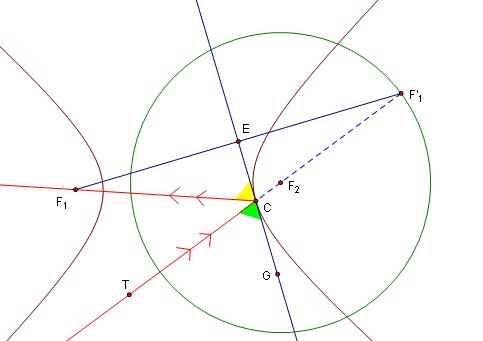 Image 21:
Outside the Hyperbola, HypCons6.gsp
Image 21:
Outside the Hyperbola, HypCons6.gsp
Last sketch will play a key role in our next project.
Cassegrain Telescope Design in GSP:
On the parabola page, we learned that parabola collects light rays, which are perpendicular to its directrix, on the focus. When we need to construct a telescope, collecting light rays at one point is enough. Additionally this point must be outside of the telescope. Newton used a flat mirror to move this point out side of the telescope. Laurent Cassegrain made a similar telescope but he used a hyperbolic mirror instead of flat mirror.
To understand this telescope better, we will examine the second reflection property (image 21) of the hyperbola.
To do that, we will trace the ray CT on the image 21 when point  in on the right half of the circle.
in on the right half of the circle.
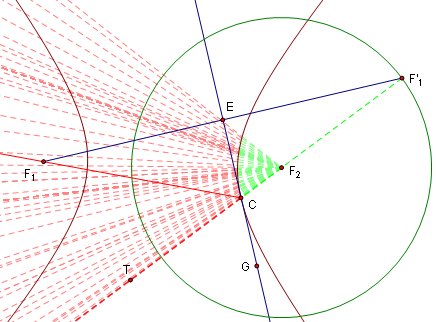 Image 22:
HypCons7.gsp
Image 22:
HypCons7.gsp
Imagine that we have only right side of the hyperbola as a mirror. Trace of rayCT is similar to light rays collected by parabola at its focus.
Now lets trace the rays  which is a
reflecting part of ray TC.
which is a
reflecting part of ray TC.
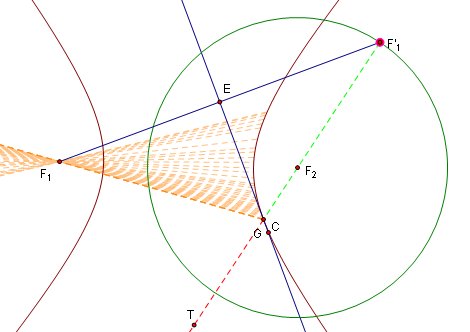 Image 23:
HypCons8.gsp
Image 23:
HypCons8.gsp
What hyperbolic mirror made is simply it collected the light rays, which comes toward its one focus, at the other focus.
To demonstrate this property we will use only one side of the circle. which will enable construct only one side of the hyperbola.
Now we can go to the next step
Click here to go to Step 6: Cassegrain Telescope.